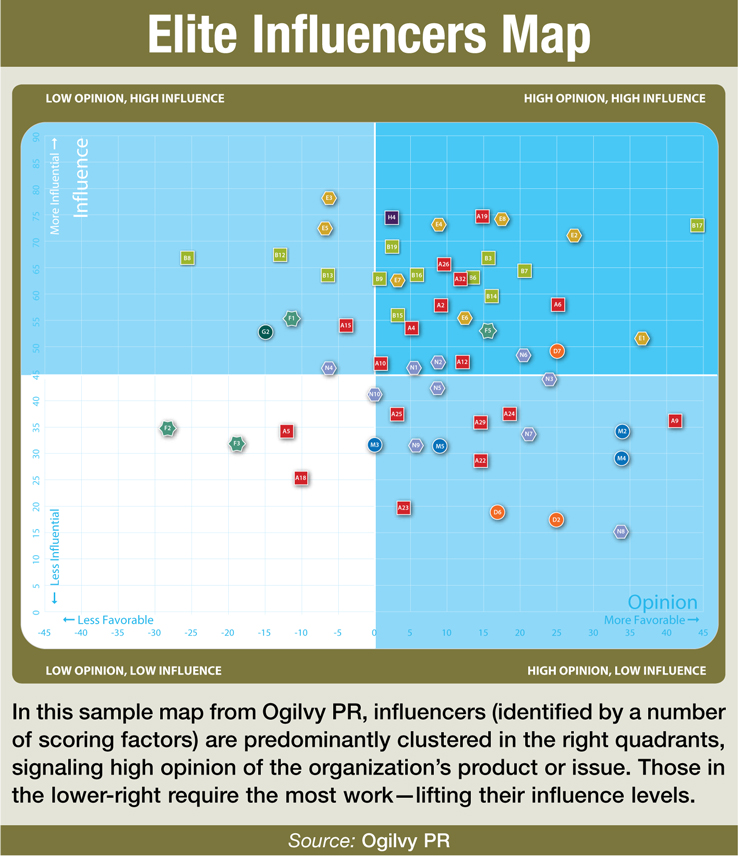For several years, engaging influential third parties and stakeholders has been a strategy of PR executives as they look to build awareness and improve the reputations for their organizations or clients.
Jennifer Scott, managing director of research and insights at Ogilvy PR, saw the practice really hit its stride a few years ago. “A big trigger was increased investment in PR in general,” says Scott. “As organizations moved away from platforms such as ads, mapping influencers and stakeholders was a clear way to understand and reach the key players who could move an organization’s needle.”
As the years have passed, improvements in mapping tool technologies have made influencer analysis more accessible to resource-challenged PR executives.
In the case of Ogilvy PR, the agency has designed the “Influencer Quotient (IQ)” mapping tool, which can map individuals or organizations, and has mapped influencers for:
• Pharmaceutical companies launching new drugs.
• Consumer companies trying to revitalize product brands.
• Companies and organizations trying to navigate public policy issues.
INFLUENCER RESEARCH
The good thing about mapping is that it can be done effectively on a smaller scale (and budget). Ogilvy’s process does provide a good blueprint for other organizations seeking to implement their own mapping efforts.
The first step is researching influencers. Using analyst and search experts, the agency does an internal audit of potential influencers, and then using public and syndicated resources (some paid and some free) such as Google, LexisNexis, Newslibrary.com, Zoominfo, LinkedIn, Congressional Record and more, they score the influence and opinion of each candidate. The scores are based on “dimensions,” such as prominence, reach and level of authority for influence, and consistency and accessibility for opinion.
MAPPING SCORES
The scores are then translated to a map with four quadrants specified as “Low Opinion, High Influence,” “High Opinion, High Influence,” “High Opinion, Low Influence” and “Low Opinion, Low Influence” (see graphic for a sample map).

The research can be a lengthy process, but the real work is just getting started, says Scott. “You want to keep your ‘High Opinion, High Influence’ group engaged,” she says. “But the most productive quadrant is on the lower right-hand side, “High Opinion, Low Influence.” Ogilvy helps clients cultivate this group, raising their influence levels by “inviting them to speak to the press for commentary,” says Scott, for example.
But what do you do with negative influencers? Frank Mantero, director of corporate citizenship programs for GE, says it’s pointless to try to change their predilections. “My position is that we love skeptics of our company,” says Mantero. “It’s the cynics that are worse. You can be extremist on the position, but if an influencer comes in with bad assumption about our business, we don’t engage with them.” In fact Mantero has had to drop a few CSR influencers because they had turned cynical.
TRACKING INFLUENCERS
Mantero’s CSR group has been doing formal stakeholder mapping for more than a year, concentrating on raising awareness of GE’s key sustainability issues: environment, climate and regulation. The process, done with the help sustainable business consulting firm BSR and a few other agencies, has helped fill in the gaps of influence within the group.
“With some key influencers, we have the right relationship on the right issue,” says Mantero. “With others we have a good relationship on the wrong issue. Some organizations like the World Bank are just huge, and just because you made one contact there doesn’t mean it’s in the right sphere of influence.”
For Lara Crissey, associate director of public affairs and communications at pharmaceutical company Boehringer Ingelheim, a negative influencer can be a positive, just by knowing what their opinions are. “It’s good to see what all influencers are saying or how they feel,” says Crissey. “For us the mapping is about making sure that people are informed.”
And when you find out what those influencers are talking about, it’s the ones that are the most credible, collaborative and informative who you want to get to know better, says Kara Hurst, vice president at BSR. “Some influencers come to table with concerns, but not solutions,” she says. “Influencers with solutions-oriented outlooks are the most effective communicators for your organization.”
To get the most out of your stakeholders or influencers, Hurst offers these tips:
• Before you map, find out who, throughout the organization, is already talking to influencers. Don’t duplicate efforts.
• When a key influencer is reached, make sure to have a top decision maker available. They want to talk to business leaders.
• Don’t stop after identifying influencer or stakeholder targets. That’s only half of the process, “and with many companies, we’ve seen the engagement cycle just end,” says Hurst.
KEEP MAPPING MOVING
Mantero agrees that to be effective, the mapping process needs to be ongoing. “It constantly helps us as we develop new CSR perspectives and stories,” he says. The mapping also used by other GE units around key issues such as financial markets and healthcare, but Mantero is encouraging more GE units to get involved in the mapping process.
Ogily’s Scott has seen the benefits after creating some 25 maps in the past two years. From that experience, she’s built a list of mapping habits to avoid:
• Overinvesting in the most positive and influential advocates.
• Neglecting low-profile supporters.
• Worrying too much about isolated opponents.
• Chasing after high-profile stars that are “just not that into you.”
• Failing to engage on the issues of interest to the third party.
Mantero sums up the benefits of mapping at GE this way: “What you’re looking for is those stakeholders who can speak to the practices of GE in an intelligent way.” PRN
CONTACT:
Jennifer Scott, [email protected]; Frank Mantero, [email protected]; Lara Crissey, [email protected]; Kara Hurst, [email protected].
